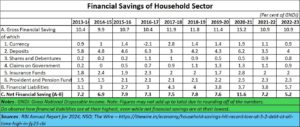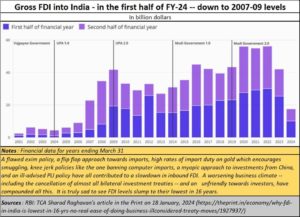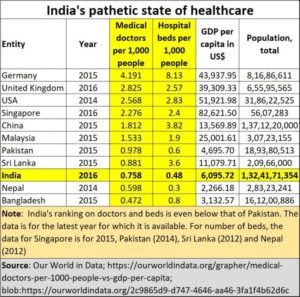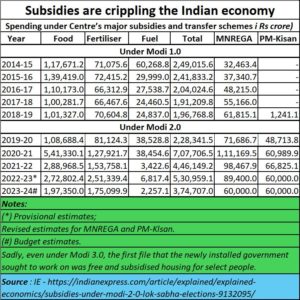The lights are flashing red about the Indian economy, but the merriment continues
By RN Bhaskar
The stock markets continue to soar. Except for a slight hiccup post elections, there seems to be no stopping the inexorable rise. Government spokespersons promise brighter times for the Indian economy. So do key spokespersons for the market and the industry.
Do listen to Ashish Chauhan, MD, National Stock Exchange: “India is going to make huge progress on the back of a young population, rapid technological developments and its entrepreneurs over the next 50 years. India’s wealth is going to increase 1,000 per cent, that is ten times, over the next 50 years,” (https://www.business-standard.com/economy/news/country-s-wealth-will-increase-1-000-in-next-50-years-nse-md-chauhan-124061901125_1.html).
This is even when corporate profits are not as wonderful as many expected. Rural demand is down. That, in turn, has slowed the manufacturing sector. Household savings are down to their lowest (https://thewire.in/economy/household-savings-hit-record-low-at-5-2-debt-at-all-time-high-infy23-rbi).
The fall in household savings is matched by another decline – gross FDI (foreign direct investment) do look up Free subscription — https://bhaskarr.substack.com/p/the-government-paints-an-inflated?sd=pf .
FDI is perhaps one of the most critical indicators which can show if investments in manufacturing or wealth generation in India have been going up or not. It is also an indicator of the confidence that foreign investors have in India.
The confidence that foreign investors have in the country might not have been that critical had domestic private investment been high. But with household savings declining, the money left for investments too has been declining. That in turn affects the setting up of new businesses, and consequently employment.
What is worse is that India does not even know how to respect foreign investment. Currently there are major foreign investors who are battling government officials over the way GST (Goods and Service Tax) is sought to be levied. Compounding this is the demand that the government’s way of computing the tax should be applied retrospectively. Some of these investors are even willing to pack up their bags and leave India.
This could have been settled peacefully, had the government allowed for international arbitration. But that too is something the government has spurned (https://asiaconverge.com/2020/01/arbitration-and-investment-protection/).
The absence of investments worsens the employment situation. But the refusal to recognise facts on this front only complicates the situation further.
The first is that India has one of the highest unemployment numbers in this region (free subscription — https://open.substack.com/pub/bhaskarr/p/poor-education-will-eventually-damn?r=ni0hb&utm_campaign=post&utm_medium=web&showWelcomeOnShare=true).
The second is that even though unemployment numbers appear to have been reducing post 2021, the latest ILO report in March this year (https://www.businessinsider.in/india/news/in-india-being-educated-might-increase-your-chances-of-unemployment-ilo-report/articleshow/108893300.cms) shows that “the proportion of unemployed youth with an education has surged from 54.2% in 2000 to a staggering 65.7% in 2022”.
There are two reasons for this.
First, there is a slump in employment for jobs which have been taken over by artificial intelligence. ChatGPT for instance has made many of the routine jobs redundant. For instance, a lawyer friend informs me that 92% of the work of checking the correctness of grammar and spelling in legal documents is done by ChatGPT. Hence instead of having many employees poring over documents, he now requires just one or maybe two. Moreover, the time saved is significant.
But it is the second factor that should worry planners who chart out scenarios for the Indian economy. It is that India’s education sector is sick. India’s legislators spend more time on debating which topics should be included in textbooks, and what language should be imposed on students, than on improving the quality of education, especially in science and mathematics which are crucial for any job in later years. At the school level, education sucks.
Government schools account for over 65% of enrolment of students in India. Hence when such schools are found wanting, most students suffer (https://www.youtube.com/watch?v=m74BaqgWD-g&t=36s).
The recent exposures about the manipulation of marks at the National Eligibility cum Entrance Test (NEET) and the utter ineptness of the recently created NTA (National Testing Agency) further stirs up the rancid waters.
Unfortunately, legislators appear to be blissfully unconcerned about the simple fact – that no country can become great without first addressing the quality of education. When academic standards decline, students get certificates declaring that they are graduates, but are eventually rejected by employers as being unemployable.
Linked to education is the issue of a tottering healthcare system. India loves announcing new schemes – like the one on Ayushman Bharat (https://asiaconverge.com/2018/08/ayushman-bharat-great-concept-doctors-overlooked/).
Once again, planners for the Indian economy are either unconcerned, or are unwilling to protest. Thus, legislators remain disdainful about a basic fact — No medical insurance system can succeed without there being enough doctors.
And that is precisely what India has forgotten to do. It has succumbed to the pressures from politicians who run medical colleges and have made it a sickening exercise in profiteering at the cost of quality of education. These vested interests have ensured that the number of medical seats too do not increase. That in turn pushes students to go overseas to study, or pay huge extortionate sums by way of capitation fees.
The result is the worsening quality of medical practitioners in India, who are also inadequate in numbers as well. Consequently, the costs of medicare go up, and people end up paying more for substandard service. As the chart above shows, even Pakistan has more doctors per 1,000 people than India has.
What could actually derail the Indian economy far more swiftly is the love that Indian legislators have for giving doles and subsidies. They do not realise that when subsidies are given for protracted periods of over a year, they teach people not to work. They cripple an entire generation of workers (Free subscription — https://bhaskarr.substack.com/p/rbi-seeks-to-conceal-govt-deficit?sd=pf).
Thus, you have a double whammy effect. Many of those who are educated are not employable. And when they can accept jobs that do not require medium to elevated levels of education, the government teaches them not to work.
As a result, India is currently nurturing a large mass of youth who will remain unemployable for over a decade. The demographic dividend is rapidly becoming a demographic nightmare. Savvy economists never tire of reminding Indian spokespersons for the government that once upon a time, Iran too had a demographic dividend (https://asiaconverge.com/2016/04/768north-india-is-a-demographic-time-bomb/). But little education, unemployment, and poverty destroyed the advantage that youth was supposed to have. India is rapidly hurtling in the same direction.
A keg of gunpowder
Adding a spark to this keg of gunpowder is the government’s penchant to release convicted criminals just to get votes. The memory of how mass rapists in the Bilkis Bano case were released, only to be sent back to jail by the Supreme Court (https://indianexpress.com/article/explained/sc-overturns-remission-bilkis-bano-rapists-9099776/) still rankles many. Ditto for the release of convicted criminals like Asaram and Ram Rahim.
That is why the euphoria in the markets and the exultant pronouncements of policy makers fills many with anxiety. The first step towards reforming the Indian economy is recognising the flaws that hobble it.
=========================
Do watch my latest podcast on the man who created one of India’s largest banks with just 25 paise deposits at https://www.youtube.com/watch?v=eyajE_rN230












































COMMENTS